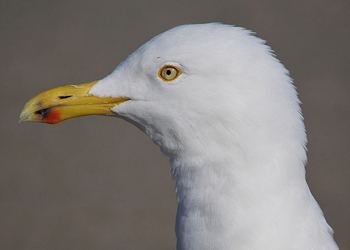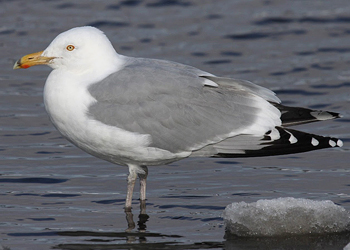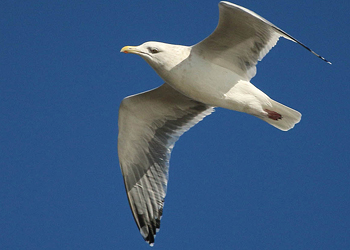 American Herring Gull (smithsonianus)
American Herring Gull (smithsonianus)
(last update: October 30, 2015)
American Herring Gull 3rd cycle (4cy) January
The Peterson Reference Guides
GULLS OF THE AMERICAS
- Steve N.G. Howell / Jon Dunn -
Below is a copy of chapter 25 about American Herring Gull, illustrated with images from this website. "we" in the text below refers to the original authors. If any errors occur in this text, please let me know and mail to marsmuusseatgmaildotcom.
American Herring Gull (smithsonianus)
LENGTH 22-26.3 IN. (56-67 CM)
IDENTIFICATION SUMMARY
The most widespread, large, pink-legged gull in N. America, common in much of the East, more local and less common in the West. Bill fairly stout and parallel edged, relatively slender on some females (especially first-cycle birds). Gonydeal expansion usually distinct but bill not bulbous tipped. At rest, tail tip falls between tips of P6 and P7. Adult has pale gray upperparts (Kodak 4-5, averaging slightly paler on birds breeding in e. N. America) with black wingtips (white mirrors on outer 1-2 primaries) and, in basic plumage, extensive dusky head and neck streaking and mottling. Juvenile dark brown overall with mostly blackish tail. PA1 variable, starting Sept.-Feb. Subsequent ages variable in appearance. All ages have pink legs; adult eyes staring pale lemon; orbital ring yellow-orange.
Large size, pale gray back, black wingtips, pink legs, and pale eyes with yellow-orange orbital ring are a distinctive combination among adults of regularly occurring New World gulls. Mostly dark brown and dark-tailed first-cycle plumage distinct among large gulls in the East, but in the West note especially Western Gull (stockier and broader winged, black bill more bulbous tipped, lacks distinct pale inner primary panel), Thayer’s Gull (slighter in build with more slender bill, outer primaries contrastingly pale on inner webs), and California Gull (more slender and narrower winged, bill typically flesh pink with clean-cut black tip, lacks distinct pale inner primary panel). See Similar Species and Rarer Species accounts for details.
TAXONOMY
See introductory section to the Herring Gull complex. Crochet et al. (2002) and Liebers et al. (2004) found that smithsonianus is not closely related to European Herring Gull and should be treated as a separate species, often known as American Herring Gull (see review by Yésou (2002)); smithsonianus is also called Hudsonian Gull (Yésou (2003)). Traditionally, smithsonianus has been considered insufficiently different (based on morphology and plumage) to warrant even sub-specific recognition from European Herring Gull (Voous 1959)). Measurements of smithsonianus and nominate argentatus are not statistically different (Threlfall & Jewer 1978), but adults of these two taxa are distinguished by the gray tone of their upperparts. In addition, adults within N. America exhibit variation in adult wingtip pattern and perhaps other characters (Jonsson and Mactavish 2001), suggesting that more than one New World subspecies may be distinguishable.
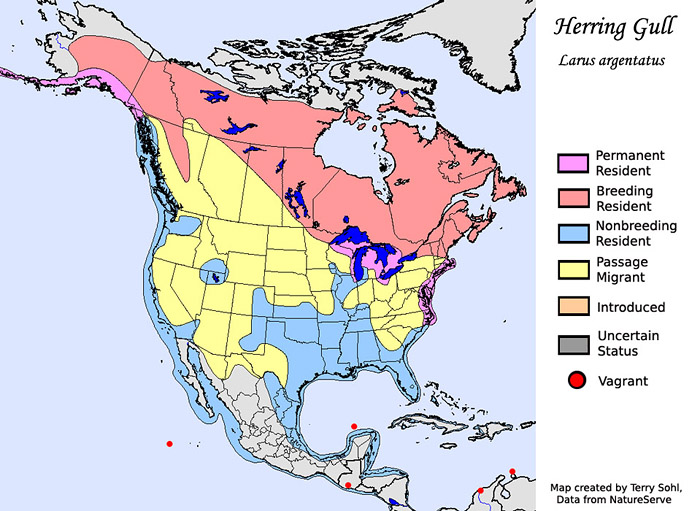
STATUS & DISTRIBUTION
N. America, wintering to Middle America. Vagrant to w. Europe and Hawaii.
Breeding.
Breeds (May-Aug.) from much of Alaska (except the w. coast, n. slope, Aleutian Is., and southeast), Yukon, and s.-cen. B.C. east through Canada to Lab. and Nfld., south to cen. Minn., entire Great Lakes region, various lakes from NY to N.H., and along Atlantic Coast from Maritimes south to S.C. During twentieth century, breeding range has greatly expanded in Great Lakes region and south along Atlantic Coast. Since late 1980s, breeding reported on Chandeleur Is., La. (Purrington 1994), and in Cameron Co., s. Tex (Farmer 1990).
Nonbreeding.
In nw. N. America, fall movement begins by mid-July in s. Yukon, Aug. in interior B.C. and Alta., mid-Sept. in the Northwest (a few as early as Aug.), and Oct. in Calif. (a few by mid-Sept.). Arrives around mid-Sept. in cen. Great Plains. In e. N. America, away from breeding areas, southbound movement evident by early July from as far south as Ohio B., but not widespread until Aug.-Sept. By Oct., has arrived continent wide, with marked increase during mid-late Oct. Peak numbers are not reached in Great Lakes region until Nov.-Dec. Numbers decline in many n. regions (such as the Yukon) during Sept., but often numerous into Oct., with last birds departing by mid-Nov. Typically departs Prairie Provinces by mid-Dec., and great majority vacate n. Great Lakes region during coldest winter periods.
Fairly common to locally common in winter (mainly Oct.-Apr.) along and near Pacific Coast from sw. Alaska to nw. Mex. (uncommon along much of immediate coast in range of Glaucous-winged and Western Gulls), but overall far less numerous in w. N. America than in the East. Also fairly common well off-shore in n. Pacific (out to 1,000 km, Sanger 1970). Uncommon to rare south to cen. w. Mex., and rare to casual (mainly Nov.-Apr.) south to Costa Rica and cen. Panama. Farther south on Pacific Coast, reported as accidental in Colombia and in Peru. (Krabbe et al. 2001). On Atlantic Coast, common to fairly common in winter (mainly Oct.-Apr.) from Nfld. south to Fla., Gulf of Mex., and locally in n. West Indies; thence uncommon to rare south through Caribbean and along mainland coasts to cen. Panama, casually to n. Venezuela.
Also winters in interior N. America (where prefers large lakes) locally throughout the West north to s.-cen. B.C., from cen. Great Plains and s. Great Lakes region south through Tex., and in the Southeast. Scarcest in the Southwest, where generally rare except Salton Sea (where common).
Northward movement occurs along Pacific Coast Feb.-May, peaking late Mar.-Apr. In Great Lakes region, strong movement evident by late Feb., peaking Mar. in most areas, and continuing into Apr. in more n. areas. A few arrive in Prairie Provinces by early Mar., with more general arrival late Mar., and peak Apr.-early May. Arrival in Yukon and on sw. Hudson Bay is early Apr., with peak movements late Apr. in s. Yukon, May-early June on sw. Hudson Bay. Spring departures from most regions in N. America are by late May, but some birds oversummer.
In w. N. America, rare to casual in summer on coast and at Salton Sea. Ranges north and west (mainly June-Sept.) to Arctic coast of Alaska, Seward Peninsula, and Bering Sea Is. Summering nonbreeders occur in small to moderate numbers along s. Atlantic Coast and along entire Gulf of Mex. coast, but very rare or casual inland in e. N. America south of Ohio R. and on Great Plains. Has been collected in Greenland, and “Herring Gulls” have bred w. Greenland, but which taxon is unspecified (Boertmann 1994).
CONTINUE PART 2: FIELD IDENTIFICATION
East coast birds
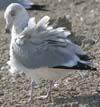 American Herring Gull (smithsonianus) 4th cycle (5CY) 0886-75788 January 26 2005, Corpus Christi, TX. Picture: Martin Reid.
American Herring Gull (smithsonianus) 4th cycle (5CY) 0886-75788 January 26 2005, Corpus Christi, TX. Picture: Martin Reid. American Herring Gull (smithsonianus) M92 3rd cycle (4CY), January 15 2015, Seabrook beach, NH. Picture: Dave Adrien.
American Herring Gull (smithsonianus) M92 3rd cycle (4CY), January 15 2015, Seabrook beach, NH. Picture: Dave Adrien.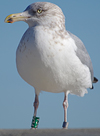 American Herring Gull (smithsonianus) V34 August 24 2013 & January 11 2016, Jenness Beach, Rye & Hampton, NH. Picture: Lauren Kras, Robbie & Colleen Prieto.
American Herring Gull (smithsonianus) V34 August 24 2013 & January 11 2016, Jenness Beach, Rye & Hampton, NH. Picture: Lauren Kras, Robbie & Colleen Prieto. American Herring Gull (smithsonianus) X36 3rd cycle (4CY), January 15 2015, Coney Island, 37th Street, Brooklyn. Picture: Klemens Gasser.
American Herring Gull (smithsonianus) X36 3rd cycle (4CY), January 15 2015, Coney Island, 37th Street, Brooklyn. Picture: Klemens Gasser.South coast birds
 American Herring Gull (smithsonianus) 4cy, January 04 2009, Coast Gulf - Texas, USA.
American Herring Gull (smithsonianus) 4cy, January 04 2009, Coast Gulf - Texas, USA.West coast birds
 American Herring Gull (smithsonianus) 3rd cycle (4cy), January 18 2006, Capitola, California, USA. Picture: Jeff Poklen.
American Herring Gull (smithsonianus) 3rd cycle (4cy), January 18 2006, Capitola, California, USA. Picture: Jeff Poklen. American Herring Gull (smithsonianus) sub-adult (5cy), January 23 2011, Monterey Bay, California, USA. Picture: Jeff Poklen.
American Herring Gull (smithsonianus) sub-adult (5cy), January 23 2011, Monterey Bay, California, USA. Picture: Jeff Poklen.